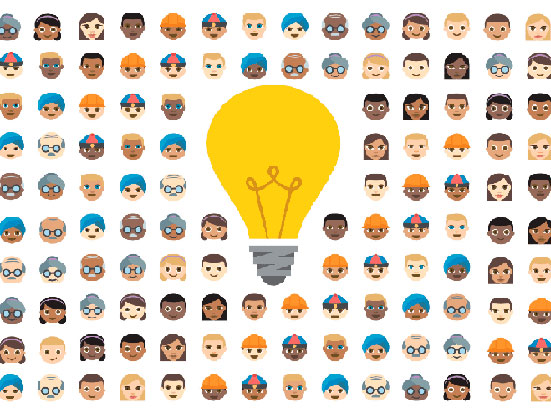It won’t be long before U.S. minorities are not in the minority anymore. Due to projected growth among Asian, Hispanic and multiracial groups, traditionally underrepresented populations will hit majority status by 2044, according to the Census Bureau.
Smart companies reflect that reality in the collective makeup of their employees. Their leaders understand that yesterday’s workforce can’t lead them into tomorrow. “We see diversity and inclusion as a business imperative,” says Wanda Hope, chief diversity officer at Johnson & Johnson in New York City.
That sentiment is shared by leaders at AT&T, where 42 percent of employees are people of color. “It makes good business sense to have an employee base that looks like our customer base,” says Cynthia Marshall, senior vice president of human resources and chief diversity officer at the Dallas-based company. “To truly serve the populations we want to serve, we need diverse groups of employees, suppliers and vendors.” AT&T attracts a diverse pipeline of applicants by partnering with universities to help prepare minority students for work; it also supports underrepresented employees through mentorships and employee resource groups.
The business case for attracting a wider range of employees will only get stronger as the country grows more diverse. “If you’re not good at attracting and retaining women and people of color, you’re competing for an increasingly smaller portion of talent,” says Joe Gerstandt, a diversity consultant based in Omaha, Neb. “And that’s a fundamentally flawed strategy.”
Performance Driver
But diversity is not just about mirroring the country’s demographics. It’s also about innovation and performance. Companies that exhibit gender and ethnic diversity are, respectively, 15 percent and 35 percent more likely to outperform those that don’t, according to global management consulting firm McKinsey & Co. And research indicates that organizations with more racial and gender diversity bring in more sales revenue, more customers and higher profits.
Diversity also matters at the top: McKinsey found that companies in the top quartile of executive-board diversity had returns on equity that were 53 percent higher than those in the bottom quartile. Moreover, organizations with more female executives are more profitable, according to a 2016 analysis of more than 20,000 firms in 91 countries.
“Attracting, retaining and developing diverse professionals stirs innovation and drives growth,” says Mike Dillon, chief diversity and inclusion officer for PwC in San Francisco.
That statement is backed by decades of sociological and economic research, and there are myriad reasons it holds true. In part it’s because people with different backgrounds and perspectives bring different information to the table. Members of diverse teams can’t take for granted that their teammates think the same way they do. That leads them to question their own assumptions and anticipate alternate viewpoints. The result? More-creative ideas and solutions.
Which is exactly what a company like Johnson & Johnson needs. “Because we are an innovation company, we need a global workforce that not only represents our customers and patients but also constantly brings in new insights,” says Peter Fasolo, chief human resources officer. At Johnson & Johnson, the hiring and promotion of diverse employees is factored into the determination of managers’ annual bonuses.
[SHRM members-only resource: HR Q&As–How to Breathe New Life into your Diversity Initiative.]
Broadening Diversity
Communicating with members of diverse teams takes extra effort, but that effort leads to better collaboration and more favorable outcomes overall, says David Rock, director of the NeuroLeadership Institute in New York City. “They challenge their own and others’ thinking.”
Perhaps that explains why the concept of organizational diversity itself has become increasingly diversified—to include personality type, thinking style and other factors that influence how people see the world. Finding the right mix of individuals to work on teams, and creating the conditions in which they can excel, are key business goals for today’s leaders, given that collaboration has become a paradigm of the 21st century workplace. Yet building strong teams and attracting more-diverse workers are just two pieces of the puzzle.
“The far bigger issue is how people interact with each other once they’re on the job,” says Howard J. Ross, founder and chief learning officer at the diversity consultancy Cook Ross in Silver Spring, Md. He cites an oft-quoted maxim: “Diversity is being invited to the party; inclusion is being asked to dance.”
“Diversity is about the ingredients, the mix of people and perspectives,” Gerstandt says. “Inclusion is about the container—the place that allows employees to feel they belong, to feel both accepted and different. You need a group of people who think differently—in a container that’s safe to share those differences.”
Getting There
Make no mistake: Achieving a truly diverse and inclusive workplace is a lot of work. Among the hardest things to combat are the biases people embrace on an unconscious level—deep prejudices or stereotypes imparted by upbringing, culture and mass media that influence our perceptions about others.
Making employees aware of unconscious bias, which research has shown everyone has, is not sufficient; HR and business leaders must develop practices to mitigate it. “Education is only the beginning of the conversation,” Ross says. “It’s like joining the gym—you still have to exercise.”
Fortunately, there are many new ways that companies can get that workout. Tech tools and companies are sprouting up all over the place to help leaders hire, manage and retain a vital and diverse workforce. And an emerging crop of innovators, including those highlighted here, are thinking about diversity and inclusion in new and exciting ways that seem to represent a win-win for employees and company leaders.
“It’s beyond the right thing to do,” Marshall says.
ARTICLE SOURCE: Society for Human Resource Management






